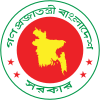Chittagong
Chittagong
চট্টগ্রাম | ||
|---|---|---|
Postal code 4000, 4100, 42xx | ||
| HDI (2019) | 0.654[5] medium | |
| Police | Chattogram Metropolitan Police | |
| Metro GDP/PPP (2020) | ||
| International airport | Shah Amanat International Airport | |
| Website | Chittagong City Corporation | |
Chittagong (
One of the world's oldest ports with a functional
The
Chittagong accounts for 12% of Bangladesh's GDP, including 40% of industrial output, 80% of
Etymology
The etymology of Chittagong is uncertain.[17] The port city has been known by various names in history, including Chatigaon, Chatigam, Chattagrama, Islamabad, Chattala, Chaityabhumi and Porto Grande De Bengala.[18]
The Bengali word for Chittagong, Chattogram (চট্টগ্রাম), has the suffix "-gram" (গ্রাম) meaning village in
One explanation credits the first Arab traders for shatt ghangh (
History


Stone Age fossils and tools unearthed in the region indicate that Chittagong has been inhabited since Neolithic times.[24] It is an ancient port city, with a recorded history dating back to the 4th century BC.[25] Its harbour was mentioned in Ptolemy's world map in the 2nd century as one of the most impressive ports in the East.[12] The region was part of the ancient Bengali Samatata and Harikela kingdoms. The Chandra dynasty once dominated the area and was followed by the Varman dynasty and Deva dynasty.
Chinese traveller Xuanzang described the area as "a sleeping beauty rising from mist and water" in the 7th century.[26]
Arab Muslim traders frequented Chittagong from the 9th century. In 1154,
Many
Sultan Fakhruddin Mubarak Shah of Sonargaon conquered Chittagong in 1340,[28] making it a part of Sultanate of Bengal. It was the principal maritime gateway to the kingdom, which was reputed as one of the wealthiest states in the Indian subcontinent. Medieval Chittagong was a hub for maritime trade with China, Sumatra, the Maldives, Sri Lanka, the Middle East, and East Africa. It was notable for its medieval trades in pearls,[29] silk, muslin, rice, bullion, horses, and gunpowder. The port was also a major shipbuilding hub.
Dhaniya Manikya conquered Chittagong in 1513. Hossain Shah sent his noble commander Gorai Mallik to attack Tripura. Gorai Mallik recaptured the territories lost. But the following year Dhaniya Manikya again conquered Chittagong.[34]
Chittagong featured prominently in the military history of the Bengal Sultanate, including during the



During the 13th and 16th centuries,
Two decades after
Portuguese ships from Goa and Malacca began frequenting the port city in the 16th century. The cartaz system was introduced and required all ships in the area to purchase naval trading licenses from the Portuguese settlement.[39] Slave trade and piracy flourished. The nearby island of Sandwip was conquered in 1602. In 1615, the Portuguese Navy defeated a joint Dutch East India Company and Arakanese fleet near the coast of Chittagong.

In 1666, the Mughal government of Bengal led by viceroy
In 1685, the British East India Company sent out an expedition under Admiral Nicholson with the instructions to seize and fortify Chittagong on behalf of the English; however, the expedition proved abortive. Two years later, the company's Court of Directors decided to make Chittagong the headquarters of their Bengal trade and sent out a fleet of ten or eleven ships to seize it under Captain Heath. However, after reaching Chittagong in early 1689, the fleet found the city too strongly held and abandoned their attempt at capturing it. The city was possessed by the Nawab of Bengal until 1793 when East India Company took complete control of the former Mughal province of Bengal.[42][43]
The
Arakan was annexed in 1829 and incorporated into the Bengal Presidency. Agriculturalists from Chittagong played a key role in the development of the rice economy in Arakan.[44] The economy of northern Arakan was integrated with the Chittagong economy. During this period, Arakan Division became one of the top rice exporters in the world.[45][46] Bengalis from Chittagong were vital to the success of Arakan's rice industry.
Railways were introduced in 1865, beginning with the
The Chittagong armoury raid by Bengali revolutionaries in 1930 was a major event in British India's anti-colonial history.
World War II
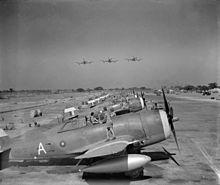
During World War II, Chittagong became a frontline city in the
After the
715 soldiers are buried at the Chittagong War Cemetery, which is maintained by the Commonwealth War Graves Commission. Allied soldiers constitute the bulk of burials in the cemetery. A few Japanese soldiers are also buried. Remembrance Day services are held each year at the cemetery, with diplomats from Commonwealth countries like the UK, Bangladesh, Australia, India and Pakistan, as well as the United States and Japan, usually in attendance.[51]
Modern

The
The lawyer and industrialist A K Khan, who set up A K Khan & Company in the aftermath of World War II, represented Chittagong in the federal cabinet of East and West Pakistan. However, East Pakistanis complained of a lack of investment in Chittagong in comparison to Karachi in West Pakistan, even though East Pakistan generated more exports and had a larger population. The Awami League demanded that the country's naval headquarters be shifted from Karachi to Chittagong.[61]
During the
After the war, the
In
Geography
Topography
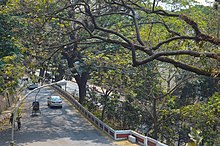
Chittagong lies at 22°20′06″N 91°49′57″E / 22.33500°N 91.83250°E. It straddles the coastal foothills of the Chittagong Hill Tracts in southeastern Bangladesh. The Karnaphuli River runs along the southern banks of the city, including its central business district. The river enters the Bay of Bengal in an estuary located 12 kilometres (7.5 mi) west of downtown Chittagong. Mount Sitakunda is the highest peak in Chittagong District, with an elevation of 351 metres (1,152 ft).[74] Within the city itself, the highest peak is Batali Hill at 85.3 metres (280 ft). Chittagong has many lakes that were created under the Mughal rule. In 1924, an engineering team of the Assam Bengal Railway established the Foy's Lake.[74]
Major sediment outflows from the Ganges and Brahmaputra rivers form tidal flats around the city.[75]
Ecological hinterland
The Chittagong Division is known for its rich
Patenga beach in the main seafront of Chittagong, located 14 kilometres (8.7 mi) west of the city.
Climate
Under the Köppen climate classification, Chittagong has a tropical monsoon climate (Am).[78]
Chittagong is vulnerable to North Indian Ocean tropical cyclones. The deadliest tropical cyclone to strike Chittagong was the 1991 Bangladesh cyclone, which killed 138,000 people and left as many as 10 million homeless.[79]
| Month | Jan | Feb | Mar | Apr | May | Jun | Jul | Aug | Sep | Oct | Nov | Dec | Year |
|---|---|---|---|---|---|---|---|---|---|---|---|---|---|
| Record high °C (°F) | 33.4 (92.1) |
36.0 (96.8) |
37.2 (99.0) |
39.6 (103.3) |
39.5 (103.1) |
37.7 (99.9) |
34.4 (93.9) |
33.9 (93.0) |
36.3 (97.3) |
34.4 (93.9) |
35.5 (95.9) |
32.5 (90.5) |
39.6 (103.3) |
| Mean daily maximum °C (°F) | 26.0 (78.8) |
28.3 (82.9) |
30.8 (87.4) |
31.9 (89.4) |
32.4 (90.3) |
31.7 (89.1) |
31.0 (87.8) |
31.4 (88.5) |
31.8 (89.2) |
31.7 (89.1) |
30.0 (86.0) |
27.2 (81.0) |
30.4 (86.7) |
| Daily mean °C (°F) | 19.8 (67.6) |
22.3 (72.1) |
25.7 (78.3) |
27.9 (82.2) |
28.6 (83.5) |
28.4 (83.1) |
27.9 (82.2) |
28.1 (82.6) |
28.3 (82.9) |
27.7 (81.9) |
24.9 (76.8) |
21.2 (70.2) |
25.9 (78.6) |
| Mean daily minimum °C (°F) | 14.0 (57.2) |
16.3 (61.3) |
20.5 (68.9) |
23.6 (74.5) |
24.9 (76.8) |
25.4 (77.7) |
25.2 (77.4) |
25.3 (77.5) |
25.2 (77.4) |
24.1 (75.4) |
20.3 (68.5) |
15.8 (60.4) |
21.7 (71.1) |
| Record low °C (°F) | 7.7 (45.9) |
10.6 (51.1) |
15.0 (59.0) |
18.0 (64.4) |
18.0 (64.4) |
20.5 (68.9) |
22.5 (72.5) |
21.0 (69.8) |
21.0 (69.8) |
19.6 (67.3) |
11.0 (51.8) |
9.9 (49.8) |
7.7 (45.9) |
| Average precipitation mm (inches) | 7.3 (0.29) |
25.0 (0.98) |
55.5 (2.19) |
136.4 (5.37) |
314.0 (12.36) |
591.3 (23.28) |
735.6 (28.96) |
513.9 (20.23) |
239.3 (9.42) |
197.8 (7.79) |
59.5 (2.34) |
14.1 (0.56) |
2,889.7 (113.77) |
| Average rainy days | 1 | 2 | 4 | 8 | 13 | 16 | 19 | 17 | 13 | 7 | 3 | 1 | 104 |
| Average relative humidity (%)
|
73 | 70 | 74 | 77 | 79 | 83 | 85 | 85 | 83 | 81 | 78 | 75 | 79 |
| Mean monthly sunshine hours | 264.1 | 244.3 | 276.4 | 242.7 | 227.2 | 116.7 | 105.1 | 124.4 | 166.7 | 218.2 | 241.3 | 245.5 | 2,472.6 |
| Source 1: Bangladesh Meteorological Department[80][81][82] | |||||||||||||
| Source 2: Sistema de Classificación Bioclimática Mundial (extremes),[83] Deutscher Wetterdienst (sun, 1961–1990)[84][a] | |||||||||||||
Government

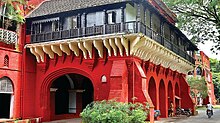

The
The
Military
Chittagong is a strategically important military port on the Bay of Bengal. The
Diplomatic representation
In the 1860s, the American consulate-general in the
Economy
| Top publicly traded companies in Chittagong, in 2014[99] | |||||
| Jamuna Oil Company | |||||
| BSRM | |||||
| Padma Oil Company | |||||
| PHP | |||||
| Meghna Petroleum | |||||
| GPH Ispat | |||||
| Aramit Cement | |||||
| Western Marine Shipyard | |||||
| RSRM | |||||
| Hakkani Pulp & Paper | |||||
| Source: Chittagong Stock Exchange | |||||
A substantial share of Bangladesh's national GDP is attributed to Chittagong. The port city contributes 12%


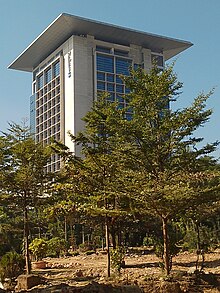

The
International banks operating in Chittagong include
By 2024, the Chittagong-based
Financial and commodity markets
Trade associations
Industrial areas
- Chittagong Export Processing Zone
- Karnaphuli Export Processing Zone
- Bangabandhu Sheikh Mujib Shilpa Nagar, Mirsarai
- Korean Export Processing Zone, Anwara
- Chinese Economic and Industrial Zone, Anwara
- Maheshkhali Economic Zone, Matarbari
- Kalurghat Heavy Industrial Area
Architecture

The Anderkilla Shahi Jame Mosque is a well-known
The old Circuit House was originally built in the style of
Culture


An inhabitant of Chittagong is called Chittagonian in English.[122] For centuries, the port city has been a melting pot for people from all over the world. Its historic trade networks have left a lasting impact on its language, culture, and cuisine. The Chittagonian language, although identified as a nonstandard dialect of Bengali, is considered to be a separate language by many linguists. The Chittagonian language has many Arabic, Persian, English and Portuguese loanwords.[21] The popular traditional feast of Mezban features the serving of hot beef dish with white rice.[122] Another dish named kala-bhuna of Chittagong, made with traditional spices, mustard oil, and beef through a special cooking style, is also renowned all over Bangladesh. The cultivation of pink pearls is a historic activity in Chittagong. Its Mughal-era name, Islamabad (City of Islam), continues to be used in the old city. The name was given due to the port city's history as a gateway for early Islamic missionaries in Bengal. Notable Islamic architecture in Chittagong can be seen in the historic Bengal Sultanate-era Hammadyar Mosque and the Mughal Fort of Anderkilla. Chittagong is known as the Land of the Twelve Saints[123] due to the prevalence of major Sufi Muslim shrines in the district. Historically, Sufism played an important role in the spread of Islam in the region. Prominent dargahs include the mausoleums of Shah Amanat, Badr Auliya, Miskin Shah, Garibullah Shah and the shrine of Bayazid Bastami among many others. The Bastami shrine hosts a pond of black softshell turtles, a critically endangered species of freshwater turtle.

During the medieval period, many poets thrived in the region when it was part of the Bengal Sultanate and the Kingdom of Mrauk U. Under the patronage of Sultan
Major cultural organizations in the city include the
Being home to the pioneering rock bands in the country like Souls[127] and LRB,[128] Chittagong is regarded as the "birthplace of Bangladeshi rock music".[129][130][131]
Demographics


| Year | Pop. | ±% |
|---|---|---|
| 1931 | 53,156 | — |
| 1941 | 92,301 | +73.6% |
| 1991 | 1,392,958 | +1409.1% |
| 2001 | 2,023,489 | +45.3% |
| 2011 | 2,582,401 | +27.6% |
| 2022 | 3,227,246 | +25.0% |
| sources:citypopulation.de | ||
At the 2011 Census, Chittagong had a population of more than 2.5 million,[132] and its Metropolitan Area had a population of 4,009,423.[133] By gender, the population was 54.36% male and 45.64% female, and the literacy rate in the city was approximately 72 percent, in 2020.
Muslims, numbering approximately 3.44 million, form the overwhelming majority of the city's population, with the rest being predominantly Hindus, numbering approximately 480,000, and the remaining 2% belonging to other religions, such as Buddhism and Christianity.[21]
Language in Chittagong District (1931)[relevant?][135]
Chittagong was a
Like other major urban centres in South Asia, Chittagong has experienced steady growth in itsMedia and communications
Various newspapers, including daily, opposition, and business newspapers, are based in Chittagong. Daily newspapers include
Chittagong has been featured in all aspects of Bangladeshi popular culture, including television, movies, journals, music, and books. Nearly all televisions and radios in Bangladesh have coverage in Chittagong. Renowned
Utilities
The southern zone of the Bangladesh Power Development Board is responsible for supplying electricity to city dwellers.[151][152] The fire services are provided by the Bangladesh Fire Service & Civil Defence department, under the Ministry of Home Affairs.[153] Total Electricity Consumption is approximately 1000 megawatts in the city proper. But in the whole Chittagong urban and city proper, it will be 1300 megawatts plus-minus. Ss power plant will be in production next year and its production power is 1320 megawatts And it creates Chittagong City as the energy production hub of Bangladesh
The water supply and sewage systems are managed by the Chittagong Water Supply and Sewerage Authority (Chittagong WASA).[154][155] Water is primarily drawn from Karnaphuli River and then purified in the Mohra Purification Plant.[156]
Chittagong has extensive
Education and research

The education system of Chittagong is similar to that of
The
The city also hosts several other private universities and medical colleges. The
Research institutes
- Bangladesh Forest Research Institute
- Bangladesh Institute of Tropical and Infectious Diseases
- Bangladesh Tea Board
Health
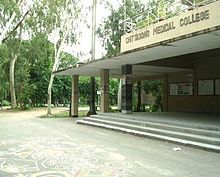
The

Private Medical Colleges:
- University of Science & Technology Chittagong
- BGC TRUST Medical College Chittagong
- Chittagong Ma o Shishu Hospital
- Southern Medical College
- Marine City Medical College
- Army Medical College
- Poly Clinic
- CSCR Hospital
Transport
Transport in Chittagong is similar to that of the capital, Dhaka. large avenues and roads are present throughout the metropolis. There are various bus systems and taxi services, as well as smaller 'baby' or 'CNG' taxis, which are tricycle-structured motor vehicles. Foreign and local ridesharing companies like Uber and Pathao are operating in the city.[172] There are also traditional manual rickshaws, which are very common.
Road

As the population has risen extensively, the Chittagong Development Authority (CDA) has undertaken some transportation initiatives aimed at easing the traffic congestion in Chittagong. Under this plan, the CDA, along with the Chittagong City Corporation, has constructed some flyovers and expanded the existing roads within the city. There are also some other major expressways and flyovers under construction, most notably the Chittagong City Outer Ring Road, which runs along the coast of Chittagong City. This
The N1 (Dhaka-Chittagong Highway), a major arterial national highway, is the only way to access the city by motor vehicle from most other parts of the country. It is considered a crowded and dangerous highway. This highway is also part of AH41 route of the Asian Highway Network. It has been upgraded to 4 lanes.[181] The N106 (Chittagong-Rangamati Highway) is another major national highway that connects the Chittagong Hill Tracts with the Oxygen Square.
Rail
Chittagong can also be accessed by rail. It has a station on the
Air
The
Sports


Chittagong has produced numerous cricketers, footballers, and athletes, who have performed at the national level.
Teams
- Chattogram Challengers – BPL (Cricket)
- Chittagong Abahani Limited – BPL (Football)
- Acme Chattogram – HCT (Field hockey)
Twin towns – sister cities
See also
- Conquest of Chittagong
Notes
Explanatory notes
- ^ Station ID for Chittagong (Patenga) is 41978 Use this station ID to locate the sunshine duration
Citations
- ^ "Protect the Queen of the East". The Daily Star. 10 July 2017. Retrieved 3 September 2021.
- ^ "Chittagong Population 2023". Retrieved 16 June 2023.
- Chittagong City Corporation. Archived from the originalon 13 August 2013. Retrieved 26 May 2013.
- ^ "Area, Population and Literacy Rate by Paurashava −2001" (PDF). Bangladesh Bureau of Statistics. Archived from the original (PDF) on 10 June 2007. Retrieved 18 September 2009.
- ^ "Sub-national HDI – Area Database – Global Data Lab". hdi.globaldatalab.org. Retrieved 11 July 2021.
- ^ a b "Economics Landscape of Chittagong". chittagongchamber.com. Chittagong Chamber. Retrieved 16 October 2019.
- ^ "Definition of Chittagong". Dictionary.com. Retrieved 23 February 2022.
- ^ a b "Mixed reactions as govt changes English spellings of 5 district names". Dhaka Tribune. 2 April 2018.
- ^ a b "Pangaon container terminal to get a boost". The Daily Star. 3 January 2016.
- ^ "Chittagong · Population". population.city. Retrieved 30 April 2022.
- ^ "Chattogram, Bangladesh Population (2023) – Population Stat". populationstat.com. Retrieved 11 March 2023.
- ^ ISBN 978-1-136-63979-1.
- ^ a b "Arabs, The". Banglapedia. Retrieved 23 February 2022.
- ^ Islam, Shariful; Hoque, Muhammad Manirul. "Unpublished Umayyad and Abbasid Silver Coins in the Bangladesh National Museum" (PDF). Journal of the Asiatic Society of Bangladesh (Hum.). 62 (2): 205–231. Archived from the original (PDF) on 9 October 2022. Retrieved 9 March 2022.
- ^ "Mint Towns". Banglapedia. 5 August 2021. Retrieved 16 March 2022.
- ^ "Chittagong | History, Population, & Facts". Encyclopædia Britannica. Retrieved 23 February 2022.
- ^ a b O'Malley, L.S.S. (1908). Chittagong. Eastern Bengal District Gazetteers. Vol. 11A. Calcutta: The Bengal Secretariat Book Depot. p. 1. Retrieved 8 August 2015.
- ^ "Bangladesh changes English spellings of five districts". bdnews24.com.
- ^ "Experts warn of trade hits from renaming Chittagong". The Financial Express. Archived from the original on 30 November 2021. Retrieved 21 March 2019.
- ^ Chowdhury, Umran (5 April 2018). "From a commercial capital to a village". Dhaka Tribune (Opinion).
- ^ a b c d e f g h i Osmany, Shireen Hasan (2012). "Chittagong City". In Islam, Sirajul; Jamal, Ahmed A. (eds.). Banglapedia: National Encyclopedia of Bangladesh (Second ed.). Asiatic Society of Bangladesh.
- ^ Bernoulli, Jean; Rennell, James; Anquetil-Duperron, M.; Tieffenthaller, Joseph (1786). Description historique et géographique de l'Inde (in French). Vol. 2. Berlin: C. S. Spener. p. 408. Retrieved 8 August 2015.
- ^ Quanungo, Suniti Bhushan (1988). A History of Chittagong. Vol. 1. Chittagong: Dipanka Quanungol Billan Printers. p. 17.
- OCLC 34115814.
- ^ "Custom House Chittagong". Archived from the original on 9 November 2015.
- ^ "Past of Ctg holds hope for economy". The Daily Star. Archived from the original on 13 April 2014. Retrieved 29 August 2013.
- ^ ISBN 1-884964-04-4. Retrieved 21 June 2015.
- ^ "District LGED". lged.gov.bd. Archived from the original on 3 November 2014. Retrieved 16 November 2013.
- ISBN 9780871692245.
- ISBN 978-0-520-05771-5.
- ^ Ray, Aniruddha (2012). "Conti, Nicolo de". In Islam, Sirajul; Jamal, Ahmed A. (eds.). Banglapedia: National Encyclopedia of Bangladesh (Second ed.). Asiatic Society of Bangladesh.
- Sen, Dineshchandra (1988). The Ballads of Bengal. Mittal Publications. pp. xxxiii.
- ^ ISBN 0-520-20507-3.
- ^ Munishi, Nayem. "Historical Muslim Monuments in Comilla". Fateh24.
- ^ "The Role of the Persian Language in Bengali and the World Civilization: An Analytical Study" (PDF). uits.edu. Archived from the original (PDF) on 31 October 2017. Retrieved 4 August 2018.
- ISBN 9780195635867.
- ^ "Bangladesh – Ethnic groups". Encyclopædia Britannica. 6 February 2024.
- ISBN 1-84331-029-5.
- ISBN 0-521-02850-7.
- ^ Chittagong, Asia and Oceania: International Dictionary of Historic Places [1]
- ^ "Shipbuilding Industry – Banglapedia".
- ^ Osmany, Shireen Hasan; Mazid, Muhammad Abdul (2012). "Chittagong Port". In Islam, Sirajul; Jamal, Ahmed A. (eds.). Banglapedia: National Encyclopedia of Bangladesh (Second ed.). Asiatic Society of Bangladesh.
- ^ Hunter, William Wilson (1908). Imperial Gazetteer of India. Oxford, UK: Oxford University Press. pp. 308, 309.
- ^ /https://www.networkmyanmar.org/ESW/Files/PS_40,_Chapter_6,_Leider_Chittagonians.pdf
- ^ Georg Hartwig (1863). The Tropical World: a Popular Scientific Account of the Natural History of the Animal and Vegetable Kingdoms in the Equatorial Regions. Longman, Green, Longman, Roberts, and Green. p. 159.
- Journal of Southeast Asian History.
- ^ https://www.dhakatribune.com/opinion/op-ed/339699/indo-bangla-economic-relations
- ^ "Nippon Bombers Raid Chittagong". The Miami News. Associated Press. 9 May 1942.
- ^ "Japanese Raid Chittagong: Stung By Allied Bombing". The Sydney Morning Herald. 14 December 1942. Retrieved 13 May 2013.
- ^ ISBN 0-912799-02-1.
- ^ https://www.daily-sun.com/post/582794/Remembrance-of-Commonwealth-War-Cemetery-Chittagong/1000
- ^ https://www.jinnahpk.com/2010/04/development-of-chittagong-port-29th-mar.html?m=1
- ^ https://en.prothomalo.com/business/a-202-year-old-iconic-family-business
- ^ https://en.prothomalo.com/business/a-202-year-old-iconic-family-business
- ^ https://en.prothomalo.com/business/a-202-year-old-iconic-family-business
- ^ https://business-america.com/alihussain-akberali/
- ^ https://static.theceomagazine.com/content/downloads/pdf/EMEA_2016_March_Aameir_Alihussain_BSRM_Manufacturing.pdf
- ^ https://en.banglapedia.org/index.php?title=Eastern_Refinery_Limited
- ^ https://www.ficci.org.bd/page/Souvenir-pbQ0h
- ^ Osmany, Shireen Hasan (2012). "Chittagong City". In Islam, Sirajul; Jamal, Ahmed A. (eds.). Banglapedia: National Encyclopedia of Bangladesh (Second ed.). Asiatic Society of Bangladesh.
- ^ Mannan, Abdul (25 June 2011). "Rediscovering Chittagong – the gateway to Bangladesh". Daily Sun (Editorial). Dhaka. Archived from the original on 1 February 2014.
- ^ "Operation Jackpot". Banglapedia.
- ^ https://www.thedailystar.net/zias-declaration-19001
- ^ Administrator. "Muktijuddho (Bangladesh Liberation War 1971) part 37 – Bangladesh Biman Bahini (Bangladesh Air Force or BAF) – History of Bangladesh". Archived from the original on 23 November 2015. Retrieved 11 October 2015.
- ISBN 9788172120016– via Google Books.
- ^ Kamal Hossain, Bangladesh: Quest for Freedom and Justice (UPL)
- ^ "In the Spirit of Brotherly Love". The Daily Star. 29 May 2014.
- ^ "Rescue Operation on Demining and Clearing of Water Area of Bangladesh Seaports 1972–74". Consulate General of the Russian Federation in Chittagong. Archived from the original on 4 March 2016.
- ^ https://www.dhakatribune.com/opinion/longform/320294/yuri-redkin-a-martyr-in-salvaging-chittagong-port
- ^ https://en.prothomalo.com/business/a-202-year-old-iconic-family-business
- ^ https://www.tbsnews.net/bangladesh/ctg-port-gets-new-terminal-after-15-years-532846
- ^ https://www.thedailystar.net/supplements/bangabandhu-sheikh-mujibur-rahman-tunnel/news/the-inauguration-south-asias-first-underwater-tunnel-3454781
- ^ https://bsmsn.gov.bd/
- ^ a b "About Chittagong". muhammadyunus.org. Archived from the original on 4 May 2015. Retrieved 6 June 2015.
- doi:10.1890/130260.
- ^ "Flora and Fauna – Bangladesh high commission in India". bdhcdelhi.org. Archived from the original on 20 August 2013.
- ^ "Protected Areas". bforest.gov.bd. Archived from the original on 17 August 2013.
- ISSN 1027-5606.
- ^ "NOAA's Top Global Weather, Water and Climate Events of the 20th Century" (PDF). NOAA Backgrounder. 2012. Retrieved 30 April 2012.
- ^ "Climate of Bangladesh" (PDF). Bangladesh Meteorological Department. pp. 19–23. Archived from the original (PDF) on 24 December 2018. Retrieved 24 December 2018.
- ^ "Normal Monthly Rainy Day" (PDF). Bangladesh Meteorological Department. Archived from the original on 9 July 2017. Retrieved 24 December 2018.
- ^ "Normal Monthly Humidity" (PDF). Bangladesh Meteorological Department. Archived from the original on 24 December 2018. Retrieved 24 December 2018.
- ^ "Bangladesh - Chittagong" (in Spanish). Centro de Investigaciones Fitosociológicas. Archived from the original on 7 January 2019. Retrieved 23 February 2013.
- ^ "Station 41978 Chittagong (Patenga)". Global station data 1961–1990—Sunshine Duration. Deutscher Wetterdienst. Archived from the original on 17 October 2017. Retrieved 31 January 2016.
- ^ "CCC mayor Nasir vows to fulfil pre-election pledges". Daily Sun. Dhaka. 10 May 2015.
- ^ Karim, A.K.M. Rezaul (2006). "Best Practice: A Perspective of 'Clean and Green' Chittagong" (PDF). The First 2006 Workshop Population and Environmental Protection in Urban Planning. Kobe, Japan: Asian Urban Information Centre of Kobe. Archived from the original (PDF) on 6 June 2015. Retrieved 5 June 2015.
- ISBN 978-971-561-607-2.
- ^ Raihan Islam. "CCNA :: Chittagong Naval Area". ccna.mil.bd. Archived from the original on 6 June 2015.
- ^ "Special Warfare Diving and Salvage (SWADS)". ShadowSpear. 22 August 2010. Archived from the original on 6 June 2015. Retrieved 5 June 2015.
- ^ "PM awards National Standard to BAF Base Zahurul Haque". New Age.
- ^ "Indo-American Relations: From Emergence into Strength" (PDF). span.state.gov. Archived from the original (PDF) on 1 July 2011. Retrieved 11 January 2022.
- ^ Mustafa Osman Turan Ambassador. "T.C. Dışişleri Bakanlığı – Embassy Of The Republic Of Türkiye In Dhaka – Büyükelçilik". Dhaka.emb.mfa.gov.tr. Retrieved 27 February 2022.
- ^ "Let's make a prosperous future for Chittagong industries | Bangladesh | Countries & Regions". JICA. 7 November 2018. Archived from the original on 31 March 2022. Retrieved 27 February 2022.
- ^ "Honorary Consul Mirza Shakir Ispahani – Federal Foreign Office". Dhaka.diplo.de. 24 November 2017. Retrieved 27 February 2022.
- ^ "Appointment Ceremony of Honorary Consul for Chittagong". Embassy of the Republic of Korea in People's Republic of Bangladesh.
- ^ "Honorary Consulate of Malaysia in Chittagong". High Commission of Malaysia, Dhaka.
- ^ "Consular Network". Ambdhaka.esteri.it. 31 March 2005. Retrieved 27 February 2022.
- ^ "Philippines opens visa centre in Ctg". The Financial Express. Dhaka. 11 February 2019.
- ^ a b "Chittagong Stock Exchange". Chittagong Stock Exchange Limited.
- ^ "Lack of requisite infrastructure". The Daily Star. 9 April 2012. Archived from the original on 4 November 2014. Retrieved 4 November 2014.
- ^ a b Ethirajan, Anbarasan (4 September 2012). "Bangladesh pins hope on Chittagong port". BBC News.
- ^ "BRI and S Asian geopolitics: the Bangladesh factor". Asia Times.
- ^ "Maritime Silk Road and Economic Belt: Emerging opportunities for Bangladesh". The Daily Star.
- ^ "China's 'maritime Silk Road' to focus on infrastructure". The Hindu.
- ^ "Ctg EPZ 4th in global ranking". The Daily Star. Archived from the original on 4 November 2014. Retrieved 4 November 2014.
- ^ "GSK looks to fortify its Bangladesh presence". The Daily Star.
- ^ "Ctg's share in garment exports on the decline". The Daily Star. Archived from the original on 4 November 2014. Retrieved 4 November 2014.
- ^ "The region is Ctg's oyster". The Daily Star. Archived from the original on 22 October 2013. Retrieved 19 May 2013.
- ^ Shariful. "Growing Up With Two Giants". muhammadyunus.org. Archived from the original on 4 November 2014. Retrieved 4 November 2014.
- ^ a b "S Alam Group contributing to the country's economy with mega investments". 5 January 2024.
- ^ "S Alam Group set to invest Tk 580b in two special industrial zones".
- ^ "S Alam's Aladdin's lamp". 4 August 2023.
- ^ "Bangladeshi group pays S$135m for Centrium Square's retail space, Property – THE BUSINESS TIMES". 9 July 2016.
- ^ "অনুরণন: Revival of Anderkilla Shahi Jame Mosque". 2 March 2020.
- ^ "Kadam Mubarak Mosque – Banglapedia".
- ^ "JM Sen Hall stands witness to an eventful century in Chittagong".
- ^ "Storied tale of PK Sen Sattala: The grand old building of Chattogram". 4 October 2022.
- ^ "'Preserve PK Sen Bhaban as heritage'". 4 November 2010.
- ^ "An old demand for a new bridge over Karnaphuli".
- ^ "Kalurghat Bridge – Banglapedia".
- ^ "A 202-year-old iconic family business | Ispahani Group of Companies".
- ^ a b "Majestic Mezban". The Daily Star. 10 October 2013. Retrieved 23 June 2016.
- ISBN 9781136831898.
- ISBN 81-7066-966-9, pp. 208–11
- ^ "Of Shiva Chaturdashi and Sitakunda". The Daily Star. Archived from the original on 4 March 2016. Retrieved 23 June 2016.
- ^ "Chronicle/Snippets". ctgdiocese.com. Archived from the original on 12 February 2020. Retrieved 23 June 2016.
- ^ "Bangladesh band SOULS: The idea of co-existence is central to our music". The Times of India. 11 December 2012. Archived from the original on 5 April 2013. Retrieved 2 September 2013.
- ^ Imran, Nadee Naboneeta (11 October 2012). "Ayub Bachchu The rock guru". New Age. Archived from the original on 3 September 2013. Retrieved 2 September 2013.
- ^ "Concert: 'Rise of Chittagong Kaos'". The Independent. Retrieved 2 September 2013.
- ^ "Warfaze and Nemesis perform Friday in Ctg". Dhaka Tribune. Retrieved 2 September 2013.
- ^ "Rocking concert: Rise of Chittagong Kaos". The Daily Star. Retrieved 2 September 2013.
- ^ "Population & Housing Census-2011: Union Statistics" (PDF). Bangladesh Bureau of Statistics. p. 39. Archived from the original (PDF) on 8 December 2015. Retrieved 15 December 2015.
- ^ "Bangladesh: Districts and Cities". citypopulation.de.
- ^ "Chittagong district – Zila statistics" (PDF). bbs.gov.bd. Bangladesh Bureau of Statistics.
- ^ "Census of India 1931" (PDF). pp. 192–193.
- ^ Chakma, Niru Kumar (2012). "Buddhism". In Islam, Sirajul; Jamal, Ahmed A. (eds.). Banglapedia: National Encyclopedia of Bangladesh (Second ed.). Asiatic Society of Bangladesh.
- ISBN 9788182202474.
- ISBN 9780878083619.
- ^ "Motif artisans in Ctg race against time as Eid nears". The Daily Star. Retrieved 31 August 2013.
- ^ "Bihari colony buzzes with Eid activities". Daily Sun. Archived from the original on 3 November 2013. Retrieved 31 August 2013.
- ISBN 978-1-4755-4352-0.
- ^ "Slum-dwellers living in fear of eviction". Daily Sun. Archived from the original on 22 February 2014. Retrieved 30 August 2013.
- ^ "Illegal structures close in on Ctg railway". New Age. Archived from the original on 22 February 2014. Retrieved 30 August 2013.
- ^ Chowdhury, Iftekhar Uddin. "Problems of Squatter Settlements in Bangladesh : A Case of Chittagong City".
- ^ DainikAzadi.net, Daily Azadi official website
- ^ Peoples-View.org, Peoples-View official website
- ^ Cplustv, Cplustv Wikipedia Site
- ^ "Gowariker's next based on Chittagong Uprising". AbhishekBachchan.org. Archived from the original on 4 July 2015. Retrieved 22 December 2009.
- ^ "Gowarikar launches new film venture". BBC Shropshire. Retrieved 22 December 2009.
- ^ "My movies are about books that influence me: Ashutosh Gowariker". Mid Day. Mumbai. Indo-Asian News Service (IANS). 9 October 2009. Retrieved 22 December 2009.
- ^ "PDB Ctg". Bangladesh Power Development Board. Retrieved 31 August 2013.
- ^ "Electricity". National Web Portal of Bangladesh. Retrieved 31 August 2013.
- ^ ফায়ার সার্ভিস ও সিভিল ডিফেন্স অধিদপ্তর [Fire Service and Civil Defence Department]. Bangladesh Fire Service & Civil Defence (in Bengali). Archived from the original on 19 June 2013. Retrieved 31 August 2013.
- ^ "$170m World Bank support to improve Ctg water supply". The News Today. Archived from the original on 22 February 2015. Retrieved 1 September 2013.
- ^ "Second Karnaphuli water supply project launched". Dhaka Tribune. Retrieved 1 September 2013.
- ^ Rahman, Md Moksedur (2012). "WASA Chittagong". In Islam, Sirajul; Jamal, Ahmed A. (eds.). Banglapedia: National Encyclopedia of Bangladesh (Second ed.). Asiatic Society of Bangladesh.
- ^ "Coverage Map". Banglalion. Archived from the original on 19 August 2014. Retrieved 2 September 2013.
- ^ "Coverage". Qubee. Archived from the original on 21 May 2013. Retrieved 2 September 2013.
- ^ a b Mokhduma, Tabassum. "Profile of Some Schools in Chittagong". The Daily Star. Retrieved 21 August 2013.
- ^ "Activities". Board of Intermediate and Secondary Education, Chittagong. Archived from the original on 11 August 2013. Retrieved 21 August 2013.
- ^ "Primary completion exams duration increased". New Age. Dhaka. 5 August 2013. Archived from the original on 11 December 2013.
- ^ "Activities of Board". Bangladesh Madrasah Education Board. Retrieved 21 August 2013.
- ^ "O-Level Exams". British Council. Archived from the original on 29 October 2013. Retrieved 21 August 2013.
- ^ "A-level exams". British Council. Archived from the original on 28 August 2013. Retrieved 21 August 2013.
- ^ "Functions of DTE". Directorate of Technical Education. Archived from the original on 29 September 2013. Retrieved 21 August 2013.
- ^ "Activities". Bangladesh Technical Education Board. Archived from the original on 4 August 2013. Retrieved 21 August 2013.
- ^ Ullah Khan, Sadat (2012). "Chittagong College". In Islam, Sirajul; Jamal, Ahmed A. (eds.). Banglapedia: National Encyclopedia of Bangladesh (Second ed.). Asiatic Society of Bangladesh.
- ^ "Chittagong General Hospital needs care". The Daily Star. Archived from the original on 19 June 2015.
- ^ "Quality healthcare needed to make Chittagong global city". The Daily Star. Archived from the original on 5 November 2014. Retrieved 28 August 2013.
- ^ "Ctg General Hospital turns into 250-bed institution". Daily Sun. Archived from the original on 5 November 2014. Retrieved 28 August 2013.
- The Financial Express. Retrieved 28 August 2013.
- ^ "Transforming ride-sharing into sustainable business". The Daily Star. Dhaka. Retrieved 29 October 2019.
- ^ "CDA's mega project of outer ring road". The Financial Express. Dhaka. Retrieved 8 April 2013.
- ^ "Chittagong City Outer Ring Road project". Chittagong Development Authority. Archived from the original on 24 April 2013. Retrieved 8 April 2013.
- ^ "Plethora of CDA projects, port city to see dev not found in last 50 yrs". The Financial Express. Dhaka. Retrieved 8 April 2013.
- ^ "Primary alignment design of Tk 100b Ctg Marine Drive prepared". The Financial Express. Dhaka. Retrieved 8 April 2013.
- ^ "Construction of flyover, marine drive this year". The Daily Star. Archived from the original on 5 November 2014. Retrieved 8 April 2013.
- ^ "First ever river tunnel under Karnaphuli planned". The Financial Express. Dhaka. Retrieved 8 April 2013.
- ^ "Work on Karnaphuli tunnel to begin this FY: Minister". Dhaka Tribune. Archived from the original on 8 August 2013. Retrieved 5 August 2013.
- ^ "Karnaphuli tunnel construction to start this fiscal". The Daily Star. Retrieved 5 August 2013.
- ^ "Part of the 4-lane highway to be ready by June". The Daily Star.
- ^ "DEMU trains begin debut run in Ctg". Bdnews24.com. Retrieved 26 May 2013.
- ^ "Commuter trains hit tracks in Ctg". The Daily Star. Retrieved 26 May 2013.
- ^ "SAIA needs proper facilities to harness it's [sic] potential & to get out of trouble". Bangladesh Monitor. Archived from the original on 2 February 2014. Retrieved 20 January 2014.
- ^ "Chittagong Airport Development Project". Civil Aviation Authority of Bangladesh. Retrieved 22 November 2013.
- ^ a b "Chittagong Shah Amanat International Airport Departures". Flightradar24. Retrieved 2 June 2023.
- ^ Bangladesh
- Cricinfo.com. Retrieved 20 December 2009.
- ^ "MA Aziz Stadium Chittagong". Warofcricket.com. Archived from the original on 13 February 2011. Retrieved 20 December 2009.
- ^ "Zohur Ahmed Chowdhury Stadium, Chittagong". Warofcricket.com. Archived from the original on 11 February 2011. Retrieved 20 December 2009.
- ^ "Lei Nº 10.155, de 23 de Abril de 2018". leismunicipais.com.br (in Portuguese). Leis Municipais. 23 April 2018. Retrieved 15 October 2020.
- ^ "Sister Cities". kunming.cn. Kunming. Retrieved 16 June 2020.
External links
- Official Web Portal of Chittagong
- Chittagong City Corporation
- Chittagong Development Authority
- Chittagong Metropolitan Police
- Chisholm, Hugh, ed. (1911). "Chittagong". Encyclopædia Britannica (11th ed.). Cambridge University Press.

